
A fishing trawler is a commercial fishing vessel designed to operate fishing trawls. Trawling is a method of fishing that involves actively dragging or pulling a trawl through the water behind one or more trawlers. Trawls are fishing nets that are pulled along the bottom of the sea or in midwater at a specified depth. A trawler may also operate two or more trawl nets simultaneously.

A diving support vessel is a ship that is used as a floating base for professional diving projects. Basic requirements are the ability to keep station accurately and reliably throughout a diving operation, often in close proximity to drilling or production platforms, for positioning to degrade slowly enough in deteriorating conditions to recover divers without excessive risk, and to carry the necessary support equipment for the mode of diving to be used.

Aurora Australis was an Australian icebreaker. Built by Carrington Slipways and launched in 1989, the vessel is owned by P&O Maritime Services. It was regularly chartered by the Australian Antarctic Division (AAD) for research cruises in Antarctic waters and to support Australian bases in Antarctica.
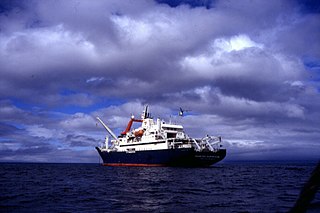
Marion Dufresne is a research and supply vessel named in honour of the 18th-century French explorer Marc-Joseph Marion du Fresne launched in 1995 and having two main missions: logistic support for the French Austral Islands and oceanographic research.

NOAAS Delaware II was a National Oceanic and Atmospheric Administration (NOAA) fisheries research vessel in commission from 1970 to 2012. Prior to her NOAA career, she was in commission in the fleet of the United States Fish and Wildlife Service's Bureau of Commercial Fisheries from 1968 to 1970 as US FWS Delaware II. After her NOAA career ended, she was sold and in 2014 was converted into the research and survey ship RV Med Surveyor, operating under the flag of Panama.
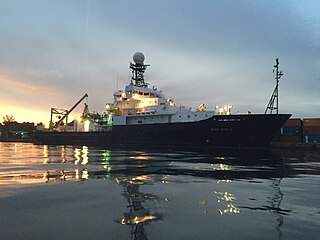
RV Roger Revelle is a Thomas G. Thompson-class oceanographic research ship operated by Scripps Institution of Oceanography under charter agreement with Office of Naval Research as part of the University-National Oceanographic Laboratory System (UNOLS) fleet. The ship is named after Roger Randall Dougan Revelle, who was essential to the incorporation of Scripps into the University of California San Diego.

RV Hugh R. Sharp is a research vessel owned and operated by the University of Delaware College of Earth, Ocean, and Environment in Lewes, Delaware operating as a member of the University-National Oceanographic Laboratory System (UNOLS). She is a replacement for Cape Henlopen.

USNS Titan (T-AGOS-15) was a Stalwart-class modified tactical auxiliary general ocean surveillance ship in service in the United States Navy from 1989 to 1993. From 1996 to 2014, she was in commission in the National Oceanic and Atmospheric Administration (NOAA) fleet as the oceanographic research ship NOAAS Ka'imimoana.

USNS Relentless (T-AGOS-18) was a Stalwart-class modified tactical auxiliary general ocean surveillance ship in service in the United States Navy from 1990 to 1993. Since 1998, she has been in commission in the National Oceanic and Atmospheric Administration (NOAA) fleet as the fisheries research ship NOAAS Gordon Gunter.
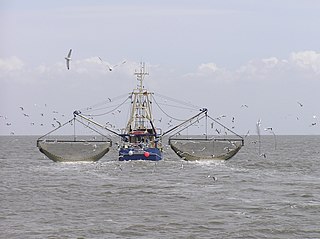
A fishing vessel is a boat or ship used to catch fish and other valuable nektonic aquatic animals in the sea, lake or river. Humans have used different kinds of surface vessels in commercial, artisanal and recreational fishing.
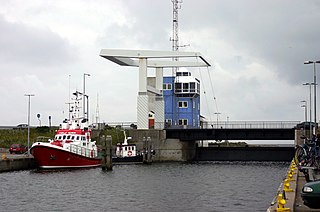
Hvide Sande is a small town in the middle of the Holmsland Dunes and placed around the artificial canal which connects Ringkøbing Fjord to the North Sea, in the western part of Central Denmark Region, formerly Ringkjøbing County, Denmark. The town has a population of 2,824 and is the fifth largest fishing port in Denmark.
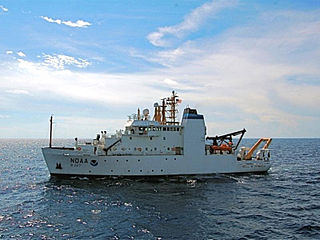
NOAAS Bell M. Shimada is an American fisheries research ship in commission with the National Oceanic and Atmospheric Administration (NOAA) since 2010. She operates along the United States West Coast.
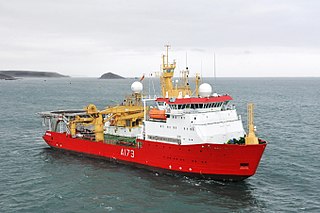
HMS Protector is a Royal Navy ice patrol ship built in Norway in mid 2000. As MV Polarbjørn she operated under charter as a polar research icebreaker and a subsea support vessel. In 2011, she was chartered as a temporary replacement for the ice patrol ship HMS Endurance and was purchased by the British Ministry of Defence in early September 2013. As DNV Ice Class 05 the vessel can handle first year ice up to 0.5 metres (20 in).

NOAAS Reuben Lasker is a National Oceanic and Atmospheric Administration (NOAA) fishery research vessel. The ship's namesake, Reuben Lasker, was a fisheries biologist who served with the Southwest Fisheries Center, National Marine Fisheries Service, and taught at the Scripps Institution of Oceanography.

USFC Fish Hawk was a fisheries science research ship operated by the United States Commission of Fish and Fisheries, commonly called the United States Fish Commission, from 1880 to 1903 and as USFS Fish Hawk by its successor, the United States Bureau of Fisheries, from 1903 1918 and from 1919 to 1926. She was the first large ship purpose-built by any country for the promotion of fisheries, and spent her 46-year career operating along the United States East Coast, in the Gulf of Mexico, and off Puerto Rico.

US FWS Albatross III was a fisheries research ship in commission in the United States Fish and Wildlife Service from 1948 to 1959. Prior to her Fish and Wildlife Service career, she operated as the commercial fishing trawler SS Harvard and briefly saw service during World War II as the United States Coast Guard patrol vessel USCGC Bellefonte (WYP-373), in commission from April to August 1944. She was wrecked in Cuba as Nyleve in 1969.
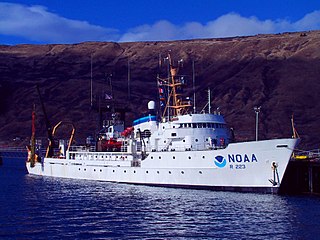
NOAAS Miller Freeman was an American fisheries and oceanographic research vessel that was in commission in the National Oceanic and Atmospheric Administration (NOAA) fleet from 1975 to 2013. Prior to her NOAA career, she was in commission in the United States Fish and Wildlife Service's Bureau of Commercial Fisheries from 1967 to 1970 as US FWS Miller Freeman.
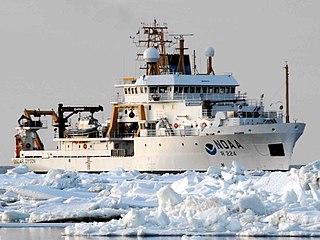
NOAAS Oscar Dyson is an American fisheries and oceanographic research vessel in commission in the National Oceanic and Atmospheric Administration (NOAA) fleet since 2005.

NOAAS Pisces is an American fisheries and oceanographic research vessel in commission in the National Oceanic and Atmospheric Administration (NOAA) fleet since 2009.

RSVNuyina is an icebreaking research and supply vessel intended to support Australian scientific activities and research bases in Antarctica. Capable of deploying a wide range of vehicles, including helicopters, landing barges and amphibious trucks to support the resupply operation, the new ship provides a modern platform for marine science research in both sea ice and open water with a large moon pool for launching and retrieving sampling equipment and remotely operated vehicles.




















